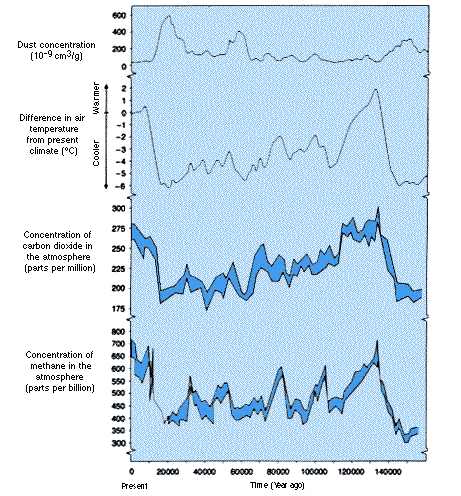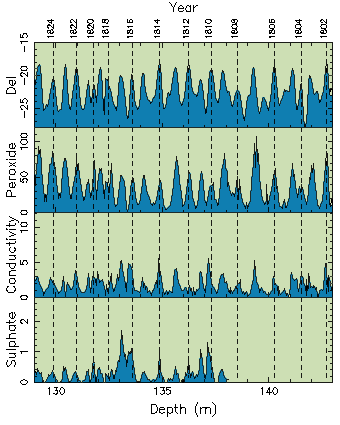
http://www.antdiv.gov.au/aad/sci/glacio/issues_glacio/issues_glacio.html
Dr. T.H. Jacka, Glaciology Program,
Antarctic Cooperative Research Centre and
Australian Antarctic DivisionFor more information, email: glaciology@antdiv.gov.au

Figure 1 Scientists measure ice cores from deep drilling sites on
the ice sheet near Casey station
Photo by M.Holmes, 1993
© Copyright Australian Antarctic Division
Antarctica is the coldest, windiest, highest and driest continent on Earth. That's right - the driest ! Antarctica is a desert. The annual precipitation of snow, averaged across the continent, is about 30 centimetres, which is equivalent to about 10 centimetres of water. In some locations as little as 2 centimetres (water equivalent) is recorded. Because of the low temperatures, however, there is little or no melt. Thus the snow has accumulated year after year for thousands of years and, with time, is compressed to ice to form the Antarctic ice sheet. Approximately 98 per cent of the Antarctic continent is covered by the ice sheet which is on average about 2,500 metres thick and, at it's deepest location, 4,700 metres thick. It is due to this thick ice mass that Antarctica is, on average, the highest continent. Since the ice sheet is formed by the accumulation of snow year after year, by drilling from the surface down through the ice sheet, we drill our way back in time. Ice drills are designed to collect a core as they cut through the ice, so samples are collected that are made up of ice deposited (in the form of snow) many thousands of years ago.
As the snow is deposited on top of the ice sheet each year, it traps
different chemicals and impurities which are dissolved in the ice. The ice
and impurities hold information about the Earth's environment and climate
at the time of deposition. A variety of different analyses techniques are
used to extract that information.
One measurement, the oxygen isotope ratio or delta value, measured using a mass spectrometer on melted samples of the ice, gives us an indication of the temperature at the time the ice was deposited as snow. Measuring the delta value at many depths through the ice core is equivalent to measuring the air temperature at many times in the past. Thus, a climatic history is developed. Climatic temperature against time from delta measurements taken on the ice core drilled at the Russian station, Vostok, in central Antarctica (Figure 2). Available data from this ice core so far extends back about 160,000 years. However, drilling of the core still continues, and it is expected that, when drilling is completed in a few years time, an age of 500,000 years will have been reached. Starting on the right-hand side of the graph at about 140,000 years ago, the climate was about 6°C colder than it is today. This was an ice age period. Then at about 130,000 years ago, there was a quite rapid warming period until about 125,000 years ago, when the climate was, perhaps, 1°C or 2°C warmer than today. These short warmer periods are called inter-glacials. We are in an inter-glacial now. From 120,000 to about 20,000 years ago, there was a long period of cooling temperatures, but with some ups and downs of a degree or two. This was the Wisconsin Period, known as the last Great Ice Age. From about 18,000 or 19,000 years ago to about 15,000 years ago, the climate went through another warming period to the next inter-glacial, - the one we are now in.
Figure 2 also includes a graph of the concentration of dust in the ice
core. High concentrations of dust occur at the same times as the colder
periods shown on the temperature graph.
There are several possible reasons for this:

Figure 2. Dust concentration, climatic air temperature (as inferred
from del measurements), and concentration of carbon dioxide and methane
from measurements of trapped air are plotted against time before present.
(After Lorius et al., 1993 and Petit et al., 1990).
The snow near the surface of the ice sheet is like a sponge with channels of air between the snow grains. As more and more snow is accumulated on top, the underlying snow is compressed into ice and the air forms bubbles in the ice. Ice cores therefore can be analysed not just for the chemical and physical properties of the ice, but also for the properties of the air trapped in the ice. These bubbles are actual samples of the atmosphere up to thousands of years ago. So, analysis of them can tell us much about the atmosphere in the past.
Concentrations of carbon dioxide and methane measured in the air bubbles trapped in the ice are shown in Figure 2 along with temperature and dust graphs. Carbon dioxide and methane are greenhouse gases and the similarity between the graphs for their concentrations and the temperature change graph indicates that the greenhouse effect is real and that it has been around for many thousands of years.
Has there been a significant increase in the atmospheric concentration of greenhouse gases since the industrial revolution?
The answer is yes, as can be seen from Figure 3 which shows the concentrations of carbon dioxide in the atmosphere, measured in the bubbles from an Antarctic ice core from Law Dome near Australia's Casey Station. The concentration of carbon dioxide has increased from about 280 parts per million to 350 parts per million, which is a rise of 25 per cent since the middle of last century. Nitrous oxide and other greenhouse gases also show similar trends from analysis of the ice-core bubbles. The Law Dome ice core is at a location where the snow accumulation is much higher than at Vostok. Thus, the time scale for the Law Dome core is expanded and it can provide us with more detailed information about recent climate changes, though it can not go back in time as far as the deeper Vostok ice core.

Figure 3. Concentration of Carbon Dioxide from trapped air measurements
for the DE08 ice core near the summit of Law Dome, Antarctica. (Data measured
by CSIRO Division of Atmospheric Research from ice cores supplied by Australian
Antarctic Division)
By sampling at very fine intervals down the ice core, and provided that each annual layer of snow is thick enough, several samples from each year may be measured for the different chemical properties. It has already been seen that the delta value is related to air temperature when the snow was deposited. Because it is warmer in summer and cooler in winter, and provided the snow layers are not too disturbed by wind, the delta value can show annual cycles. Thus, these values can be used to date the ice core. Hydrogen peroxide is created in the atmosphere by a chemical reaction that requires ultraviolet light. There is a lot less ultraviolet light in the winter than in the summer in Antarctica. Thus, measurements of hydrogen peroxide dissolved in the ice also provide a good annual cycle indicator.
In order to date the ice cores accurately, the annual layers need to be thick enough to obtain about ten measurement samples from each year. The thickness of the annual layers depends on how much snow falls each year. Thus, to obtain an ice core from which accurate, detailed dating can be derived, we need to find an Antarctic site where the snow accumulation is relatively high. This would usually mean we need to find a low elevation site, but it must also be a site where there is no melt. If the snow was to melt at any time during the year, some measurements such as those involving trapped gases would be spoiled. In addition, the annual layers would be destroyed by the melt water which would, effectively, wash the evidence away.
Such locations (high snow accumulation, yet low summer temperatures) are not easy to find. One such location, however, is near the summit of Law Dome, approximately 120 kilometres from Casey Station, where an ice core has been drilled 1,200 metres through the ice sheet to the underlying bedrock. Accurate dating for this core has been obtained back to 8,000 years ago using annual cycles obtained by analysis of delta value and hydrogen peroxide. A section of the graph of delta value and hydrogen peroxide is shown in Figure 4, along with the year. The ice core depth for this section is 139 to 128 metres, corresponding to the dates 1807 to 1826 AD.

Figure 4. Detailed analysis of section of the DSS ice core (summit
of Law Dome, Antarctica) showing del value, Peroxide concentration, Sulphate
concentration and Conductivity values. Section of ice core is from 128 to
139 metres depth, covering the time period 1808 to 1826, and including evidence
of two volcanic eruptions.
Measurements of electrical conductivity are also made on the ice cores - these are closely linked to the acidity of the ice. Conductivity shows an annual cycle and is higher in the summer snow than the winter snow. This is probably because of chemical reactions in the atmosphere involving dimethyl sulphide (a chemical produced in greater quantities during the summer months by marine algae and phytoplankton), which result in production of low concentrations of sulphuric acid which is then distributed over the ice sheet. Sulphuric acid is often blasted into the atmosphere by volcanic eruptions. Therefore, the conductivity in the ice cores sometimes shows a peak at the depth corresponding to the time shortly after a volcanic eruption.
A more reliable method of detecting volcanic eruptions from the ice cores however, is to measure sulphate directly. Sulphate also exists in sea salt which is deposited on the ice sheet in small quantities from wind-blown sea spray. Thus, to examine the sulphate derived from volcanoes, the sea-salt sulphate needs first to be accounted for. This can be easily done by measuring the quantities of other chemicals of marine origin.
On Figure 4, along with the accurate dating of the ice core from delta value and hydrogen peroxide, plots of conductivity and non-sea-salt Sulphate are also included. The conductivity graph does indicate annual cycles, but more interesting are the large peaks in this and in the sulphate graphs, which occur at about 1810 and between about 1816 and 1818 AD. The 1816-18 peak is due to the eruption in 1815 of Tambora, a volcano in Indonesia. The peak in about 1810 certainly seems to be due to another volcanic eruption, but none is known to have occurred around then. Volcanic eruptions are useful to glaciologists as a check on the other ice core dating techniques. On the other hand, there are previously unknown volcanic eruptions have been discovered from the evidence from the ice cores.
Lorius, C., J. Jouzel and D. Raynaud 1993. 'The ice core record: past archive of the climate and signpost to the future'. In: Antarctica and environmental change. Oxford Science Publications. pp 27-34.
Petit, J.R., L. Mounier, J. Jouzel, Y.S. Koretkevitch, V.M Kotlyakov and C. Lorius 1990. 'Palaeoclimatological and chronological implications of the Vostok core dust record'. Nature 293: 56-58.
Wilkinson, J. 1994. 'Volcanic horizons located in the DSS ice core', Graduate Diploma with Honours Thesis, Institute for Antarctic and Southern Ocean Studies, University of Tasmania, p. 102.
(JJ_GL)
Etheridge, D. M., L. P. Steele, R. L. Langenfelds, R. J. Francey, J.-M. Barnola, V. I. Morgan. 1996. Natural and anthropogenic changes in atmospheric CO2 over the last 1000 years from air in Antarctic ice and firn. Journal of Geophysical Research, 101, D2, 4115-4128.
Another relevant reference is
Etheridge, D.M., Pearman, G.I. and Fraser, P.J. 1992. Changes in tropospheric methane between 1841 and 1978 from a high accumulation-rate Antarctic ice core. Tellus, 44B, 282-294.
CSIRO Division of Atmospheric Research
This document is http://www.antdiv.gov.au/aad/sci/glacio/issues_glacio/issues_glacio.html.